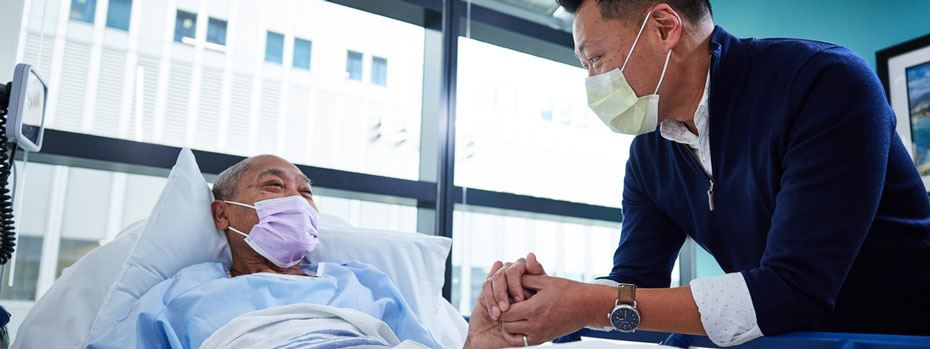Lung Cancer Diagnosis

The specialists at the OHSU Knight Cancer Institute use advanced techniques to diagnose lung cancer.
- We use the Ion robotic navigation system to see if suspicious lung nodules are cancer.
- If you have lung cancer, we can run special tests to find the best treatment for you.
- Our specialists work as a team to consider every option and clinical trial for your care.
Overview
You may seek tests for lung cancer for reasons that include:
- Symptoms of lung cancer
- Risk factors for lung cancer
- A chest scan that shows a lung nodule
Most often, the sequence looks like this:
- You get a chest scan; it may be to screen for lung cancer or for another reason.
- If the nodule is small and you have no risk factors, we may recommend just keeping an eye on it.
- If the nodule is larger or you have risk factors, we may recommend a PET scan or a biopsy (taking a tissue sample) to see if it’s cancer.
- If the biopsy shows that you have cancer, we’ll recommend treatment for lung cancer.
Lung nodules
Lung nodules are spots that show up on a chest X-ray or CT scan. Most of the time, they are not cancer. They can also be caused by:
- Infections like pneumonia or tuberculosis
- Swollen lymph nodes
- Scarring
- Cysts
Your care team will look at:
- The nodule’s size; larger nodules are more likely to be cancer.
- If it’s growing; growth can be a sign of cancer.
- How old you are; risk rises with age.
- If you have a history of smoking, which increases risk.
- If your lymph nodes look normal; abnormal nodes may be a sign of cancer.
These factors will help you and your team decide what to do next. In some cases, we may recommend monitoring the nodule to see if it changes. In others, we may recommend a biopsy to check for cancer.
Imaging
- CT scan: A computed tomography scan uses X-rays to create detailed pictures of areas inside the body. This allows doctors to see the size and location of a lung nodule or tumor.
- PET scan: For a positron emission tomography scan, a small amount of radioactive material is injected to highlight cancer cells. The scan shows if cancer has spread to another part of the body. Sometimes a PET scan is combined with a CT scan.
Biopsy
Your doctor removes a small piece of tissue or fluid from your lung or nearby organs. A doctor called a pathologist checks the tissue or fluid under a microscope for cancer cells.
Location
Knight Cancer Institute, South Waterfront
Center for Health & Healing, Building 2
3485 S. Bond Ave.
Portland, OR 97239
OHSU Knight Cancer Institute, Marquam Hill
808 S.W. Campus Drive
Portland, Oregon 97239
Free parking for patients and visitors
Refer a patient
- Refer your patient to OHSU.
- Call 503-494-4567 to seek provider-to-provider advice
Cancer clinical trials
Clinical trials allow patients to try a new test or treatment.
Read more
Learn more about OHSU Knight Cancer Institute treatments:
Bronchoscopy
Bronchoscopy is a way to get inside your lung without cutting your skin. Advanced technology allows us to check nodules that are smaller and deeper inside the lung. This helps us catch cancer earlier, when it’s easier to treat.
How does bronchoscopy work?
There are several types and techniques. This section focuses on our Ion robotic navigation system.
First we do a CT scan of your chest. This creates a 3D map of your bronchial tree, the network of airways inside your lungs. We use advanced technology to plan the best path through the airways to reach the lung nodule.
Once you are sedated, the doctor uses a narrow, flexible tube called a catheter tipped with a tiny camera and other tools. The doctor gently guides the catheter through your mouth and into your lung. Using the map as a guide, they navigate the catheter through the bronchial tree to the nodule. They remove a tiny sample to check it for cancer.
Benefits of robotic bronchoscopy
- It’s safe and accurate.
- It can reach smaller nodules that lie deeper in the lungs.
- Survival rates are higher when lung cancer is found earlier.
Fine-needle aspiration biopsy
A thin, hollow needle and syringe are used to remove fluid and tissue so they can be checked for cancer cells. The needle is guided with an ultrasound or CT scan.
Core biopsy
A larger needle is used to extract more tissue.
Other tests
- Thoracentesis: If you have fluid buildup around your lungs (pleural effusion), your doctor can use a needle to remove it and have it checked for cancer cells.
- Molecular analysis: We analyze tissue samples to identify the best treatment for you. This test may open up some extra treatment options, depending on what type of lung cancer you have.
- Pulmonary function test: This test measures how much oxygen your lungs absorb when you breathe.